CHAPTER 7 -- WING CHOON STICKING HANDS
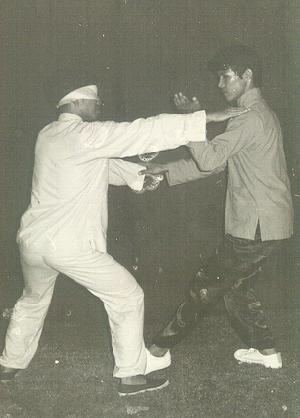
An old picture showing Grandmaster Wong, being blindfolded, engaged in "Sticking-Hand" with Sifu Koay of Choe Family Wing Choon
The art of Sticking Hands, or chi sau, is a unique feature of Wing Choon Kungfu. In some aspect it is similar, but not identical, to the "Pushing Hands" of Tai Chi Chuan, or the "Kneading Hands" of Wu Chu Kungfu. It is called Sticking Hands because two exponents practicing the art keep their hands continuously in contact when they perform various attack-defence movements. The term "hand" is used in its wide sense, and include the wrist, the forearm, and other parts of the upper limb. The aim of Sticking Hand practice is to develop sensitiveness in the hands and arms so that the proponent can sense the opponent's action without having to watch him.
In my personal way, this Sticking Hands and its subsequent sensing skill are the first fascinating features that attract me to Wing Choon Kungfu. I marvelled at the baffling manner Wing Choon masters warded off attacks blindfoldedly! Sensing skill is also found in other styles of kungfu, but it is in Wing Choon that this skill is given prominent emphasis. Sensing skill is acquired through the practice of Sticking Hands, and there are many stages in its training. Many Wing Choon masters, understandable, teach Sticking Hands exclusively to selected disciples only.
While it is not impossible, it is nevertheless not easy to learn sensing skill from a book, because it involves some subtle movements that cannot be satisfactorily described in words nor illustrated by pictures. Persoanl supervision and explanation by a generous Wing Choon master is often necessary in developing sensing skill from Sticking Hands.
The various processes in Sticking Hands are explained, with the help of illustrations, on the following pages. If one follows them carefully and practice with a co-operating partner for some time, he may acquire some of this fascinating sensing skill.
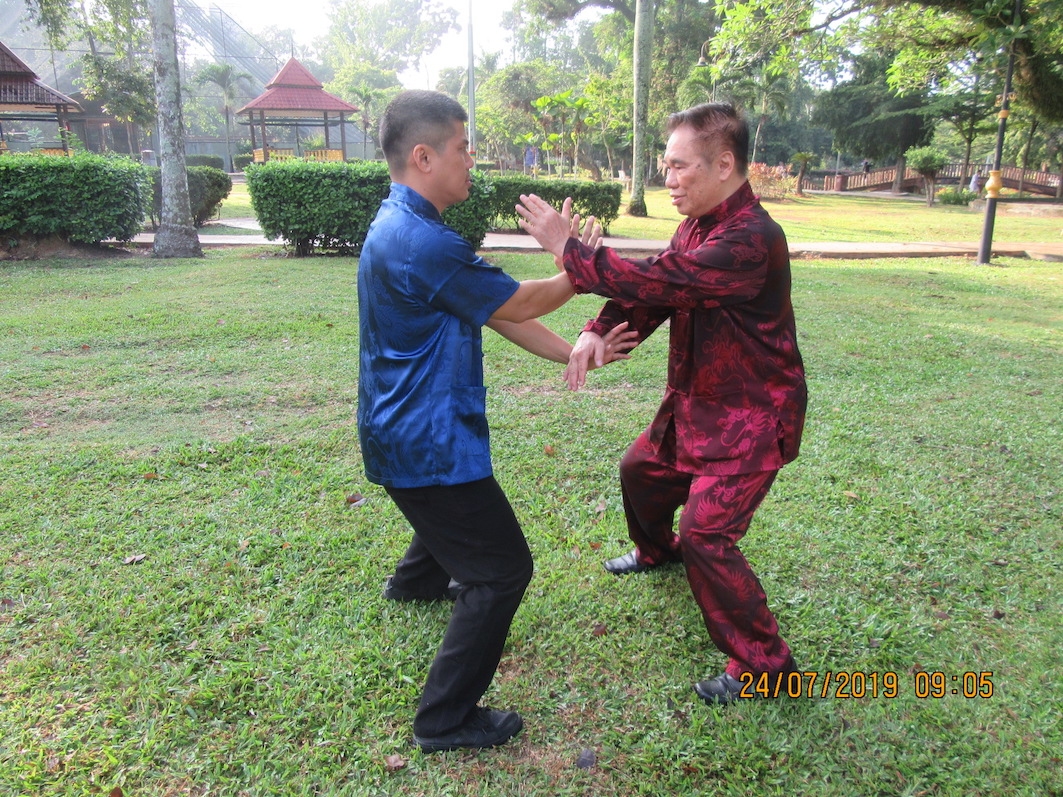
Pinning-Hand
Both exponents stand at the goat-riding stance facing each other. The arms are placed touching each other. The pinning-hand movements are continually performed. The left hands of both exponents move in a closewise direction, while the right hands move anti-clockwise. There must be no force exerted. These pinning-hand movements are to be performed continuously for a few minutes, or until the arms become tired.
Another process in the training of Sticking Hands is the circling-hand movements. The arms are placed in contact with each other. But the hands rotate in the other directions -- left hands anti-closewise and right hands clockwise. The hands are to move effortlessly in circles, without exerting any force, and the elbows are to be kept down and close to the body during the continuos circling movements.
These two processes -- pinning and circling movements -- are to be practiced daily for about three months. Perseverance of daily practice is essential to the development of this fascinating sensing skill (or any kungfu skill desired). Uninitiated people may think the prolonged practice of these apparently simple pinning and circling movements redundant or unnecessary. Some may imagine that fascinating kungfu feats are acquired by means of mysterious, elaborate formulae. It may be a surprise to some people to learn that the methods to achieve these feats are actually simple (once we know them -- but the required procedure has to be practiced thousands or even millions of times to attain excellence.
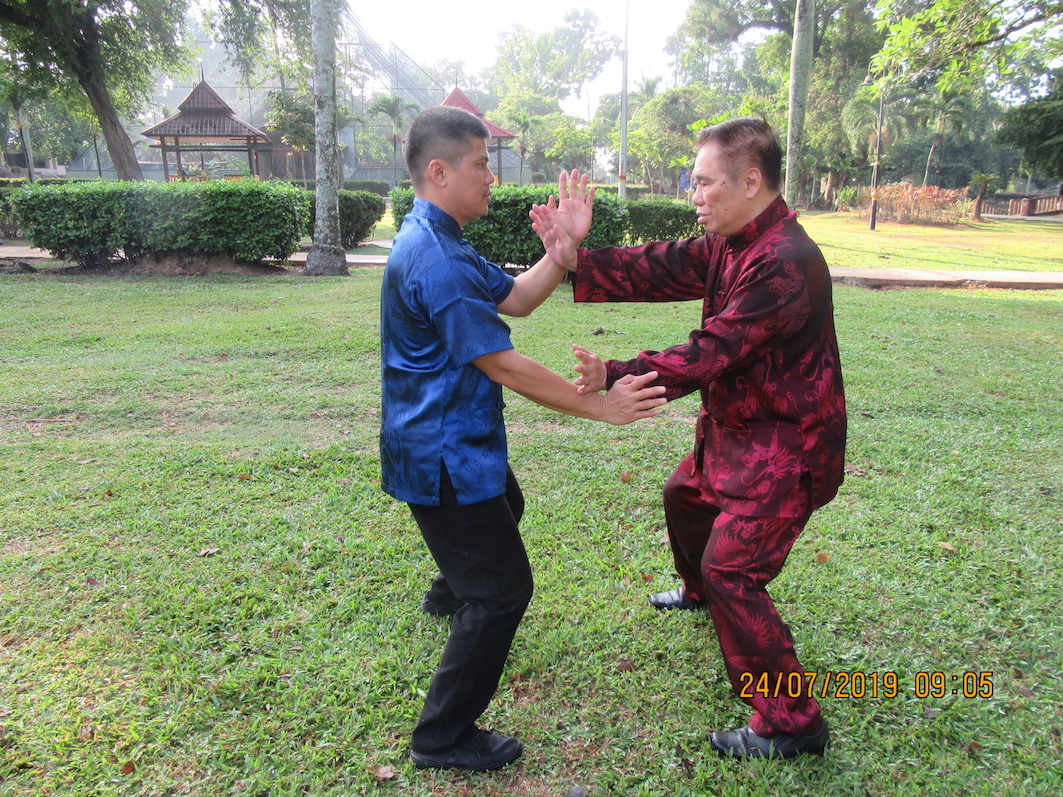
Circling-Hand
After having practiced pinning-hand and circling hand movements consistently for some months, one would feel innate force flowing to his arms. He would also feel a remarkable increase of sensitiveness. Then he can proceed to the second stage of Sticking Hands training.
At this second stage, there are many exercises aimed at making the hands sharply sensitive to various attack and defence movements. My partner and I stand at the goat-riding stance facing each other. My left hand and his right hand are in contact, and they will remain in contact continually throughout the exercise.
My partner "sinks" my hand and instantaneosly attacks me with a cup-fist. Sensing the forward movement of his arm, I deflect his punch with a mirrow-hand. Then I thrust my fingers at his throat. My partner senses my thrusting movement. Folowing my momentum, he "sink" my attack with a taming-hand.

Cup-Fist and Mirror-Hand
Continuing his taming action, he pushes my arm downward and sideways, then thrust a phoenix-eye fist at my solar plexus -- all in one smooth, continuous action. Following his punching movement, I deflect his phoenix-eye fist with a guard-hand. Note my co-ordinating body movement.

Cup-Fist and Sinking-Hand
Then I attack my partner with a cup-fist. He defends with a "sinking-hand". Immediately he attacks me with phoenix-eye fist, and I respond with a "guard-hand".
Then I attack him with a left stamp-hand which he counters by using his right taming-hand.

Reverse Stamp-Hand and Taming-Hand
Immediately my partner uses a right shooting palm to jab at my throat. I respond with a left mirror-hand. My partner then sinks my hand and attacks me with a cup-fist, and the series of movements is repeated.

Shooting-Hand and Mirror-Hand
At the initial stage the student and his partner need to practice only two or three movements. For example, they can practice only the cup-fist, the finger-thrust and their counter-movements. Both exponents A and B stand at the goat-riding stance with their wrists touching each other. A attacks with a cup-fist and B responds with a mirror-hand, followed by a finger-thrust, which A counters with a taming-hand. This short series is repdeatedly continued as A sinks B's and attacks with a cup-fist.
When one is proficient in this type of Sticking Hands, known as "Single Sticking Hands" as only one hand of each participant is in contact with each other, he can proceed to the next type of exercises known as "Double Sticking Hands", where both hands of the participants are in action.
Up to this stage of Sticking Hands training, both participants perform various movements without moving from their goat-riding stance. This stage is hence called "Stationary Footwork Sticking Hands".
At the next stage, the participants move about accordingly as they practice prearranged Sticking Hands movements. For example, while executing a cup-fist, one may move forward to the four-six stance, and the partner may retreat backwards or move sideways to avoid the on-coming force. Thus, this stage is called "Mobile Footwork Sticking Hands".
At this stage, therefore, participants develop not only sensitive hand movements, but also sensitive footwork. This type of training enables the exponent to maintain a close body distance with his opponent; the exponent can closely follow the opponent's retreat without having to look at the opponent's footwork. On the other hand, the Wing Choon exponent, by merely sensing the opponent's hand movements, can anticipate correctly the opponent's intended advances, and therefore can manoevre his footwork accordingly.
The movements in all these stages of Sticking Hands training (namely, pinning and circling hands, stationary footwork and mobile footwork) are prearranged. These movements are aimed at conditioning practitioners' reflexive reactions to different combative situations, and at developing sensing skill. When one is proficient in these stages, he can proceed to the fourth and final stage, that is Free Sticking Hands. At this final stage, all movements are not prearranged. It is similar, but not identical, to free sparring.
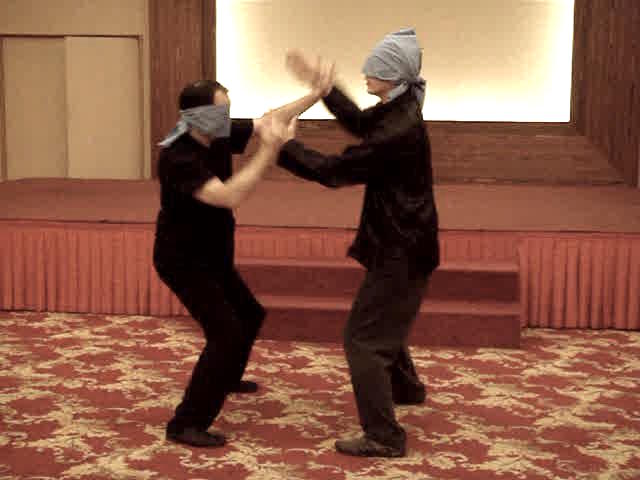
Sifu Tim and Robin Gamble who were blind-folded in Free Sticking Hands in a Special Wing Choon Course in 2010
For convenience of study, the various stages of Sticking Hands training are listed below:
- Pinning-Hands and Circling-Hands
The primary purpose is to develop sensitiveness and flowing movements.
- Stationary Footwork Sticking Hands
The primary purpose is to develop reflexive responses ti various combative movements.
- Mobile Footwork Stick Hands
The primary purpose is to develop co-ordinating footwork
- Free Sticking Hands
The primary purpose is to test various skills and techniques in Sticking Hands.
One should be fairly proficient at one stage before proceeding to the next. The length of time of practice for each stage varies greatly for different people, but a rough guide is three months of daily practice.
Here are some helpful points to remember so as to derive the best results from Sticking Hands practice:
- The hands must be in contact throughout the exercise.
- The movements must be fluid and continuous. It is recommeded to perform the various movements slowly and gracefully at first, working up a steadily increasing momentum as the participants progress.
- There should be no brutal strength exerted. If one tenses or tightens his muscles in an attempt to muster strength, he would lessen the sensitiveness of his hands. After sufficient training, one would find innate (not mechanical) force flowing into his arms.
- The onus of Sticking Hands training is to feel or sense the partner's movements. Thus, there is no need to concentrate the eyes at the movements.
- It is worthwhile to keep in mind that the primary aim of Sticking Hands is to develop hand sensitiveness, and not to defeat each other in free exchange of combative techniques. The keynote of the training, therefore, is co-operation, and not competition.
- Persistent and regular training is essential to achieving result. If one practices haphazardly, he will not be able to develop and accumulate sensing skill adequately.
An exponent with sensing skill acquired from Sticking Hands obviously has a big advantage in sparring or actual fighting. Not only he can readily deflect or avoid the apponent's attack, but because he senses an opponent's intension as soon as he initiate a move, he can also frustrate the opponent's move before it is properly executed. During combat he will therefore try to keep his hands in contact with the opponent's as much as possible.
There are two questions concerning Sticking Hands and sensing skill that people often ask. What happens if an opponent withdraws his hands and avoid contact? Is this Sticking Hands helpful against leg attacks?
If I wish to have my hands in contact with an opponent, I can realize this in two ways: by first blocking the opponent's attack, and then sticking my hands to his; and by attacking first and then keeping my hands in contact with the opponent's.
If the opponent withdraw his hand(s), I can follow the withdrawing movement, with my hand(s) still in contact with his, and strike him. However, if he withdraws or bring aside his hand(s) too fast for me to follow, then I need not maintain contact, but strike straight at him. This tactic is expained in the Wing Choon epigram, "Come retain: go send. Slip hand, straight bang!"
A Wing Choon master with a very high degress of sensing skill can often sense an opponent's leg attack without having to look at the opponent's legs. This is possible because certain movements are necessary for an effectual kick, and these movements can be detacted through Sticking Hands. There is a colloqual saying in kungfu, "that as soon as an opponent moves his shoulder, you know his kick is coming."
It is worth noting that the fundamental aim of Sticking Hands and sensing skillis are not to enable the proponent to fight blindfoldedly, but to develop his sensitiveness so that he has an added asset which is meant to supplement, not replace, his eyesight in combat.
Grandmaster Wong Kiew Kit,
18th July 2019.
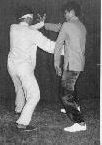
An old picture showing Gandmaster Wong and Sifu Koay, who is an inner disciple of Patriarch Choe Hoong Choy, practicing Sticking Hands
LINKS
Introduction to Wing Choon Kungfu
Courses and Classes









